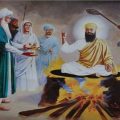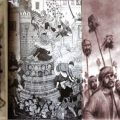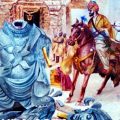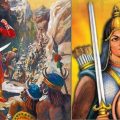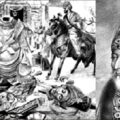Hemu Vikramaditya: Hindu Emperor Who Ruled Delhi During Akbar’s Time

“The Gods envy us. They envy us because we’re mortal. Because any moment might be our last. Everything’s more beautiful because we’re doomed.” (Troy).
Hemchandra Bhargawa or Hemu (1501-1556) was born in Alwar, Rajasthan. He was the son of Rai Puran Das, who being the chief of army and Prime Minister during the reign of Adil Shah Suri of the Suri dynasty. Hemu is recorded to have fought 22 battles on a row and won all of them before his emperor was captured and killed in Fatehpur. After his 22nd victory on 7th October, 1556, in which he defeated Tardi Beg Khan of Humayun’s army, he crowned himself as the emperor of Delhi breaking the rhetoric of establishing the Islamic rule in Delhi under the Flag of Suri Dynasty. He adopted the name “Samrat Hemchandra Vikramaditya”. According to many sources he was heavily influenced by the famed “Vijayanagara” Kingdom of South and architected his kingdom on those lines. Though Hemu’s rule being short, he was able to issue coins bearing his name and image.
To be precise, there are not many texts or sources which may be relied upon as the foundation to construct Hemu’s early life, as many texts had been destructed by the early Mughal rulers themselves. As a result, not much is known about his childhood and his early life. In fact, there is a disagreement among historians with regard to his birth name and place. According to K.K. Bhardwaj, Samrat Vikramaditya’s original name was Basant Rai, Hem Rai, Hem Raj or Hem Chandra or Bhargava. R.C. Majumder observed that “He was born in a poor family of Bhansar Section, living in a town in the southern part of Alwar”. Historian Badayuni has described him as a resident of a small town named “Rewari” in the taluk of Mewat, and began his life as a vegetable vendor. Many other historians believe that he was a hawker in the town of Mewat. Many Historians mentions and agree that he was raised within a religious environment, and he was educated in Sanskrit, Hindi, Persian, Arabic and Arithmetic. He was also equipped with Horse riding and Kushti. But, His rise to fame did not happen until late 1530’s, when he came in contact with the officers of Sher Shah Suri.
During the early 1500’s, vast portions of India were under Afghan occupation. South India (Vijaynagara), Rajputana, Orissa and Assam were the only remaining parts of India which largely remained free. From Delhi, Lodi Dynasty virtually ruled almost all of North India. Independent sultanates ruled Gujarat and Central India. During the tenure of the afghan occupation, Jizya Tax was strictly imposed upon. At this Juncture in 1526, a central Asian tribal ruler named Babur invaded India. His armies marched from Kabul to Delhi via Punjab. April 21, 1526, the first battle of Panipat was fought. This battle would be the decisive one, as the same will laid the founding stone for the Mughal Empire in India. Babur defeated the joint forces of Ibrahim Lodi and Raja Vikramjit- King of Gwalior- and captured the throne of Delhi. Thereafter, the Rajputs under the leadership of Rana Sangram Singh of Chittor challenged Babur. They got support from Hasan Khan Moe. Unfortunately, their joint forces stood defeated at the hands of Babur in the battle of Khanwa. This victory paved the way for Babur to consolidate his control over North-Western India as well as parts of Gangetic plains.
Today, the Geo-politics of South –Asian sub-continent has changed drastically, but in near antiquity the Kabul- Kandahar region was known as “Gandhara” in those days, and was very much a part of Indian Civilization. Babur says that from the time he obtained Kabul to his victory at Panipat, “I had never ceased to think of the Conquest of Hindustan”. But he had never found a suitable opportunity for undertaking it, “Hindered as I was sometimes by the apprehensions of my Begs, Sometimes by the disagreement between my brothers and myself”. Like countless invaders from Central Asia, Babur was drawn to India by the lure of its fabulous wealth. India was the land of gold and riches. Babur ancestor, Timur, had not only carried away a vast treasure and many skillful artisans, who helped him to consolidate his Asian empire and beautify his capital, but also annexed some areas in the Punjab. These areas remained in the possession of Timur’s Successors for several generations’, when Babur conquered Afghanistan; he felt that he had a legitimate right to these areas.
Guru Nanak, who was a contemporary of Babur witnessed cruelties of Babur armies upon the people, went on to observe in detail about the atrocities committed by Babur and his troops. Guru Nanak poignantly wrote “The creator has sent Babur the Mughal as Yama Disguised. There was so much slaughter and the people screamed- Didn’t You feel compassion lord?”
Babur died in January 1531 and was succeeded by his son Humayun. Sensing an opportunity, Sher Khan Suri- An Afghan Commander of the Lodis- stationed in Bihar during Ibrahim’s Lodi’s rule attacked the Mughal Empire. He defeated the Mughals in the battles of Chausa and Kannauj and drove them out of Delhi. He captured the throne at Delhi on May 1540, declared himself as the emperor and took the name of “Sher Shah Suri”. His rise was miraculous – born in a peasant family, he ascended from the rank of a private and ruled most of the northern India. After installing himself at the throne in Delhi, he pursued Humayun and chased the Mughal Army out of India. Humayun gained refuge from the King of Iran.
Hem Chandra’s rise began at around this time. He was based out of Rewari- 50 miles from Delhi – and started supplying cereals to Sher Shah’s army. In addition to supplying cereals, he started others supplies like Saltpeter (for Gunpowder) to Sher Shah’s army and continue the same supplies to Sher Shah’s Son Islam Shah. After the death of Sher Shah in 1545 Islam Shah succeeded him. Islam Shah, at early, recognized Hemu’s caliber, as a result, he initially appointed Hem- Chandra as “ Shahang-i- Bazar”, a Persian term meaning market superintendent , who managed and overseen the mercantile system across the empire. This post gave Hem Chandra the opportunity to interact with the King frequently in order to apprise him of the trade and commerce situation of the Kingdom. Hem- Chandra proved his mettle as market superintendent and he rose to become “Daroga-i-Chowki” or Chief of Intelligence. Islam Shah’s health started deteriorating. In 1552 he shifted his base of power from Delhi- Gwalior, at which point he promoted Hem Chandra as the governor of Punjab. Hem Chandra held this title until Islam Shah’s death in October 1553.
After the death of Islam Shah, Islam shah’s nephew Adil Shah killed Islam Shah’s 12 year old son Fiiruz and usurped the throne. Adil Shah was not a capable ruler. Soon after becoming King, he appointed Hem Chandra as his Wazir or Prime Minister and started neglecting his responsibities. Unhappy with the murder of Firuz and Adi Shah’s incompetence, various members of the Suri dynasty revolted against him. Soon, The Suri Kingdom divided into 4 houses. Sikandar Suri declared himself as the King of Punjab. Ismail Suri captured Delhi and Agra. Muhammad Suri Proclaimed himself as the ruler of Bengal. Only Bihar up to the vicinity of Agra remained in the possession of Adil Shah. During this period, Hem- Chandra as Prime minister proved his mettle. As a commander of Adil Shah’s army, he fought numerous battles defeating each rebellious governor. He defeated and killed Muhammad Shah Suri- self appointed ruler of Bengal. He defeated Ibrahim Shah Suri twice. More importantly, with these victories, he not only controlled the administration and the treasury, nut also the victorious armies of the empire. In the meantime, Sikandar Suri too defeated Ibrahim Suri and captured Delhi and Agra.
At this time, Sensing the anarchy and disintegration of his afghan enemies, Humayun defeated convincingly by Sher Shah Suri 15 years ago, sustained and supported by Iranian king, invaded India once again. His commander Bairam khan easily defeated Sikandar Suri and reinstalled Humayun to the throne of Delhi (July 1555). But Humayun couldn’t consolidate his control over his newly conquest kingdom as he died in January 1556.
Humayun’s death gave Hem- Chandra the perfect opportunity to defeat the Mughals. With about 50,000 soldiers, Hemu embarked on a winning march from Bengal via present day Bihar, Uttar Pradesh and Madhya Pradesh. Many Mughal officers and commanders taken surprised by the attack evacuated their positions and fled in panic on hearing the news of Hemu’s Invasion. Hem- Chandra’s army besieged Agra without a fight. He was now poised to recapture Delhi. With a shudder of lightning victories over his enemies, he commanded the respect of his forces and strengthen trust of his officers, Both Indians and Afghans at this juncture, with no De- Jure King installed, he with the consent of his commanders declared himself as the king.
Mughal General Bairam Khan being a seasoned Campaigner, sensing the gravity of the situation sent reinforcements to the Governor of Delhi- Tardi Beg Khan and the Mughal Army battled Hem- Chandra’s forces in present day Tughlaqabad in this battle. Hem- Chandra arranged 300 elephants and selected cavalry in the center with loosely guarded front and flanks. At one point it appeared as if Mughals had captured 3000 afghan men and 400 elephants. Sensing Victory, Mughal armies dispersed to plunder the enemy camp. At that Point, Hem Chandra charged on Tardi Beg‘s camp and with his reserved forces in the center, seeing a force marching directly towards them and without any armies to stop them, the Mughal commanders fled from the battlefield, this led to a total chaos within the Mughal ranks and led to their defeat.
Sir Wolsey Haig Writes “Hemu was so elated by the capture of Delhi as to believe that he had already reached the goal of his ambition.
Smith named Hemu the third claimant to the sovereignty of Hindustan during that period (the other two being Suris and Akbar). Smith asserts that Hemu after his occupation of Delhi came to the conclusion that he had a better claim to the throne of Delhi for himself rather than on behalf of Adil Shah and ventured to assume the Title of “ Raja Vikramaditya”, a title proclaimed and adopted by several great emperors in ancient times. Hemu assumed the royal robes and declared himself the emperor of India under the title of “Vikramadaitya”.
His Afghans officers were reconciled to the ascendancy of an infidel by a liberal distribution of plunder and probably also by the fact that Hem- Chandra had proved to be a successful general.
Hemu had his formal Indian “Rajyabhishek” or “Coronation” at Purana Qila in Delhi on 7th October 1556 in the presence of all the Afghan Sardars and Hindu Senapatis (military commanders). According to K.K. Bhardwaj “Thousands of guests were invited, among them were Rajput chiefs, Afghan governors and various scholars and Pandits”. The festivities continued for three- four days. “Essential parts of Hindu King’s coronation are “ writes Sir Jadunath Sarkar, “ Washing him (Abhishek) and holding the royal umbrella over his head (Chhatra Dharam) “ and Hemu may have performed theses ancient traditions accompanied by costly gifts and robes to priests. He made various appointments on the occasion, appointing his brother Jujhara Rai, governor of Ajmer and his nephew Rammayya, a general in his army. He also appointed his various supporters as Chhaudhuris and Muqqadams based on their merit, as a result most of them continued to maintain their repetitive positions during the reign of Akbar.
Thus Hemu became the first Indian to rule as the emperor of North India in 350 years. According to Abul Fazl, as recorded in the “Akbarnama” after winning Delhi Hemu had planned to attack and win Kabul. He made several changes in his army, including the requirement of many Indians in crucial positions, but without any dismay or dismissal among Afghans or any Afghan.
Due to Long Association with the Suri Administration, since the 1540’s first as a supplier of various items to Sher Shah Suri, then as superintendent of Markets, Minister of Internal Security, Governor of Punjab during Islam Shah, Prime Minister-Cum-Chief of Army during Adil Shah, Hemu had great administrative experience and sound knowledge of how system works.
Though, Hemu did not have much time to consolidate, Hemu revitalized the administration that had flunked after the death of Sher Shah Suri. With his experience and knowledge of Trade and Commerce he added fresh impetus to commerce throughout the country. He took strict measures with regard to black- marketing, hoarding, overcharging and under-weighing of goods. After he conquered Agra and Delhi, he replaced all corrupt officers. He also introduced coinage system bearing his image.
Hem Chandra’s victories and coronation caused a lot of consternation among the Mughals. Many of Akbar’s commanders advised him to retreat to Kabul and wait for an opportune moment – like his father Humayun. However, Bairam Khan the guardian of Akbar and chief strategist for army matters insisted on fighting Hem- Chandra in an effort to regain Control of Delhi. Bairam Khan realized the stark consequences, a defeat may cause. As a result, he and Akbar stayed back eight miles from the battle ground to retreat to Kabul in case of a game change.
On 5th November, 1556, the Mughal army met Hem Chandra’s army at the historic Battlefield of Panipat. The same battlefield where Babur met Ibrahim Lodi and which led to the foundation of the Mughal empire. Tactfully, Bairam Khan as an able general as he was motivated his army and ordered them to move for battle. Samrat Hem Chandra himself led his large army himself and leaving all his main generals to stabilize his kingdom sitting atop an elephant and was composed and poised to achieve victory. But fate had something else to offer. In the middle of the war, all of a sudden Samrat Hemu was hit in the eye by a stray arrow. In spite of that, Hem Chandra pulled out the arrow by his hands and exhorted his forces to charge ahead. However, due to severe and excessive bleeding, he collapsed unconscious in his “Hauda “. This changed everything. Looking at their collapsed leader, the army lost heart and no commander came forward to rise to the occasion and to make coordinated decisions. As a result of this confusion, amidst chaos Hem Chandra’s armies started losing the battle line- and an easy victory got converted into a disastrous defeat.
Unconscious, the almost dead Hem- Chandra was captured by Shah Qulin Khan and carried to the camp of Akbar where he was beheaded.
Thus, another brave son of the Motherland met a unwarranted and Gruesome end.
Suggested Readings:-
- Sarkar, Jadunath(1960). Military History of India. Orient Longmans.
- Tripathi, Ram Prasad (1960). Rise and fall of the Mughal Empire(2nd Ed.)
- Majumdar, Ramesh Chandra(1984). “Hemu: A forgotten Hindu Hero”. The History and Culture of the Indian People. Volume 7: The Mughal Empire. Bharatiya Vidya Bhavan.
- Chandra, Satish(2004). Medieval India: From Sultanate To The Mughals, Part II: Mughal Empire (1526–1748) (Third ed.). Har-Anand Publications. pp. 91–93. ISBN 9788124110669. Retrieved 17 November 2014.
- Qanungo, Kalika Ranjan (1965). Sher Shah and his Times. Orient Longmans. pp. 448–49.
- Myer, Hanna, ed. (1995). India 2001: reference encyclopedia. Columbia, MO: South Asia Publications. ISBN9780945921424. Retrieved 5 July 2016.
- Abu’l-Fazl. “Vol II, Chapter XI”. Akbarnama. Retrieved 8 July 2016.
- Richards, John F.(1995). The Mughal Empire (The New Cambridge History of India). Cambridge University Press. p. 13. ISBN 9780521566032.
- Wink, André (2012). Akbar (Makers of the Muslim World). Oneworld Publications. p. 18. ISBN9781780742090. Retrieved 17 July2016
- Roy, Kaushik (2004). India’s historic battles : from Alexander the Great to Kargil. Delhi: Permanent Black. pp. 68–79. ISBN9788178241098. Retrieved 17 July 2016.
- Eraly, Abraham(2000). Last Spring: The Lives and Times of Great Mughals. Penguin UK. ISBN 9789351181286. Retrieved 17 July2016.
- Hadi, Nabi (1994). Dictionary of Indo-Persian literature. Janpath, New Delhi: Indira Gandhi National Centre for the Arts. p. 53. ISBN9788170173113. Retrieved 12 July 2016.
- Roy, Kaushik (2013). “Fazl, Abul (1551–1602)”. In Coetzee, Daniel; Eysturlid, Lee W. (Eds.). Philosophers of war: the evolution of history’s greatest military thinkers. Santa Barbara: Praeger. pp. 43–47. ISBN978-0-313-07033-4. Retrieved 20 July 2016.
Heartiest Thanks to Bandana Singh for helping me choose the topic.
Featured image courtesy: ScoopWhoop.

